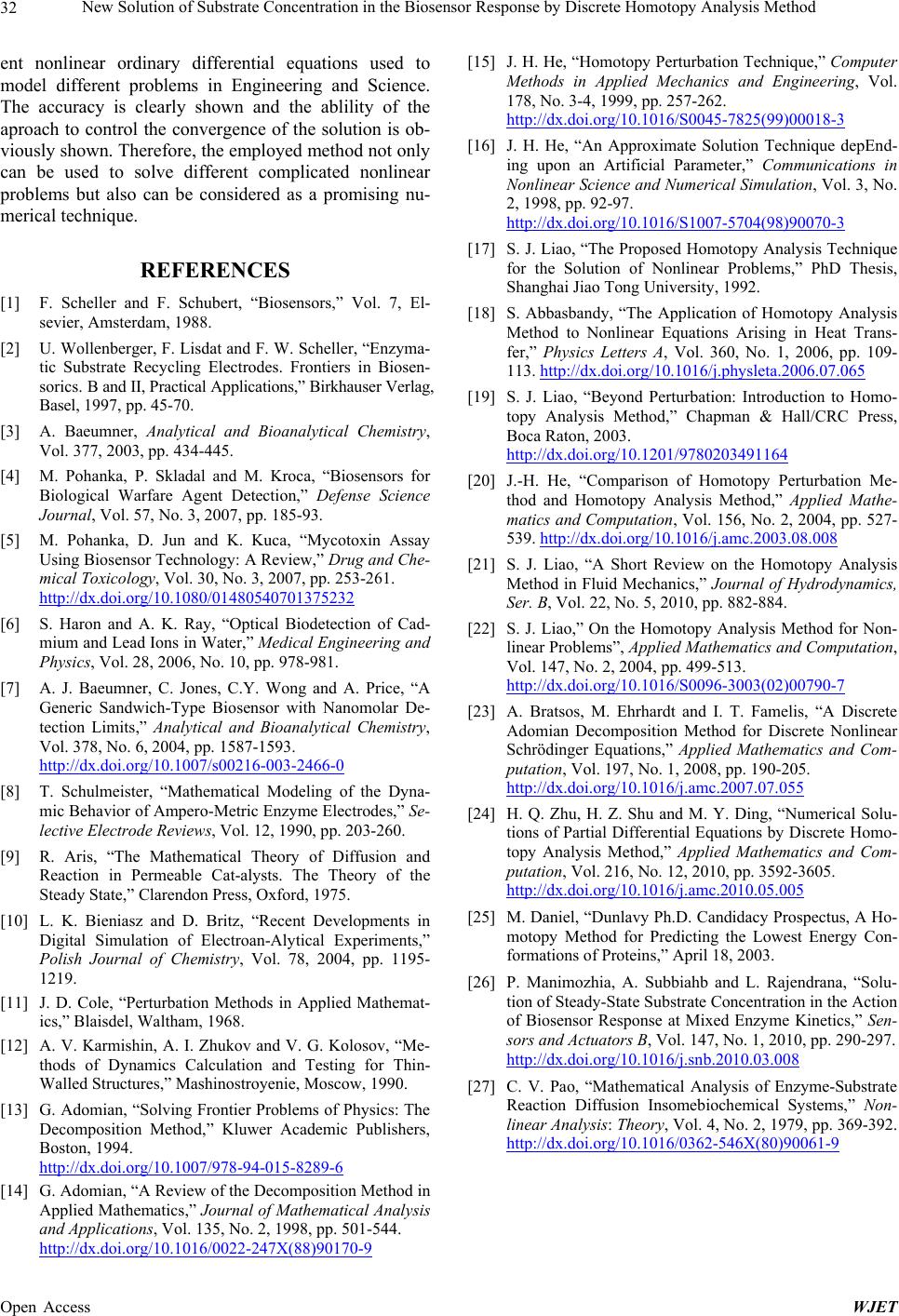
New Solution of Substrate Concentration in the Biosensor Response by Discrete Homotopy Analy sis Method
32
ent nonlinear ordinary differential equations used to
model different problems in Engineering and Science.
The accuracy is clearly shown and the ablility of the
aproach to control the convergence of the solution is ob-
viously shown. Therefo re, the employed method not only
can be used to solve different complicated nonlinear
problems but also can be considered as a promising nu-
merical technique.
REFERENCES
[1] F. Scheller and F. Schubert, “Biosensors,” Vol. 7, El-
sevier, Amsterdam, 1988.
[2] U. Wollenberger, F. Lisdat and F. W. Scheller, “Enzyma-
tic Substrate Recycling Electrodes. Frontiers in Biosen-
sor ics . B and II, Practical Applications,” Bi rkhau ser Verlag,
Basel, 1997, pp. 45-70.
[3] A. Baeumner, Analytical and Bioanalytical Chemistry,
Vol. 377, 2003, pp. 434-445.
[4] M. Pohanka, P. Skladal and M. Kroca, “Biosensors for
Biological Warfare Agent Detection,” Defense Science
Journal, Vol. 57, No. 3, 2007, pp. 185-93.
[5] M. Pohanka, D. Jun and K. Kuca, “Mycotoxin Assay
Using Biosensor Technology: A Review,” Drug and Che-
mical Toxicology, Vol. 30, No. 3, 2007, pp. 253-261.
http://dx.doi.org/10.1080/01480540701375232
[6] S. Haron and A. K. Ray, “Optical Biodetection of Cad-
mium and Lead Ions in Water,” Medical Engineering and
Physics, Vol. 28, 2006, No. 10, pp. 978-981.
[7] A. J. Baeumner, C. Jones, C.Y. Wong and A. Price, “A
Generic Sandwich-Type Biosensor with Nanomolar De-
tection Limits,” Analytical and Bioanalytical Chemistry,
Vol. 378, No. 6, 2004, pp. 1587-1593.
http://dx.doi.org/10.1007/s00216-003-2466-0
[8] T. Schulmeister, “Mathematical Modeling of the Dyna-
mic Behavior of Ampero-Metric Enzyme Electrodes,” Se-
lective Electrode Reviews, Vol. 12, 1990, pp. 203-260.
[9] R. Aris, “The Mathematical Theory of Diffusion and
Reaction in Permeable Cat-alysts. The Theory of the
Steady State,” Clarendon Press, Oxford, 1975.
[10] L. K. Bieniasz and D. Britz, “Recent Developments in
Digital Simulation of Electroan-Alytical Experiments,”
Polish Journal of Chemistry, Vol. 78, 2004, pp. 1195-
1219.
[11] J. D. Cole, “Perturbation Methods in Applied Mathemat-
ics,” Blaisdel, Waltham, 1968.
[12] A. V. Karmishin, A. I. Zhukov and V. G. Kolosov, “Me-
thods of Dynamics Calculation and Testing for Thin-
Walled Structures,” Mashinostroyenie, Moscow, 1990.
[13] G. Adomian, “Solving Frontier Problems of Physics: The
Decomposition Method,” Kluwer Academic Publishers,
Boston, 1994.
http://dx.doi.org/10.1007/978-94-015-8289-6
[14] G. Adomian, “A Review of the Decomposition Method in
Applied Mathematics,” Journal of Mathematical Analysis
and Applications, Vol. 135, No. 2, 1998, pp. 501-544.
http://dx.doi.org/10.1016/0022-247X(88)90170-9
[15] J. H. He, “Homotopy Perturbation Technique,” Computer
Methods in Applied Mechanics and Engineering, Vol.
178, No. 3-4, 1999, pp. 257-262.
http://dx.doi.org/10.1016/S0045-7825(99)00018-3
[16] J. H. He, “An Approximate Solution Technique depEnd-
ing upon an Artificial Parameter,” Communications in
Nonlinear Science and Numerical Simulation, Vol. 3, No.
2, 1998, pp. 92-97.
http://dx.doi.org/10.1016/S1007-5704(98)90070-3
[17] S. J. Liao, “The Proposed Homotopy Analysis Technique
for the Solution of Nonlinear Problems,” PhD Thesis,
Shanghai Jiao Tong University, 1992.
[18] S. Abbasbandy, “The Application of Homotopy Analysis
Method to Nonlinear Equations Arising in Heat Trans-
fer,” Physics Letters A, Vol. 360, No. 1, 2006, pp. 109-
113. http://dx.doi.org/10.1016/j.physleta.2006.07.065
[19] S. J. Liao, “Beyond Perturbation: Introduction to Homo-
topy Analysis Method,” Chapman & Hall/CRC Press,
Boca Raton, 2003.
http://dx.doi.org/10.1201/9780203491164
[20] J.-H. He, “Comparison of Homotopy Perturbation Me-
thod and Homotopy Analysis Method,” Applied Mathe-
matics and Computation, Vol. 156, No. 2, 2004, pp. 527-
539. http://dx.doi.org/10.1016/j.amc.2003.08.008
[21] S. J. Liao, “A Short Review on the Homotopy Analysis
Method in Fluid Mechanics,” Journal of Hydrodynamics,
Ser. B, Vol. 22, No. 5, 2010, pp. 882-884.
[22] S. J. Liao,” On the Homotopy Analysis Method for Non-
linear Problems”, Applied Mathematics and Computation,
Vol. 147, No. 2, 2004, pp. 499-513.
http://dx.doi.org/10.1016/S0096-3003(02)00790-7
[23] A. Bratsos, M. Ehrhardt and I. T. Famelis, “A Discrete
Adomian Decomposition Method for Discrete Nonlinear
Schrödinger Equations,” Applied Mathematics and Com-
putation, Vol. 197, No. 1, 2008, pp. 190-205.
http://dx.doi.org/10.1016/j.amc.2007.07.055
[24] H. Q. Zhu, H. Z. Shu and M. Y. Ding, “Numerical Solu-
tions of Partial Differential Equations by Discrete Homo-
topy Analysis Method,” Applied Mathematics and Com-
putation, Vol. 216, No. 12, 2010, pp. 3592-3605.
http://dx.doi.org/10.1016/j.amc.2010.05.005
[25] M. Daniel, “Dunlavy Ph.D. Candidacy Prospectus, A Ho-
motopy Method for Predicting the Lowest Energy Con-
formations of Proteins,” April 18, 2003.
[26] P. Manimozhia, A. Subbiahb and L. Rajendrana, “Solu-
tion of Steady-State Substrate Concentration in the Action
of Biosensor Response at Mixed Enzyme Kinetics,” Sen-
sors and Actuators B, Vol. 147, No. 1, 2010, pp. 290-297.
http://dx.doi.org/10.1016/j.snb.2010.03.008
[27] C. V. Pao, “Mathematical Analysis of Enzyme-Substrate
Reaction Diffusion Insomebiochemical Systems,” Non-
linear Analysis: Theory, Vol. 4, No. 2, 1979, pp. 369-392.
http://dx.doi.org/10.1016/0362-546X(80)90061-9
Open Access WJET